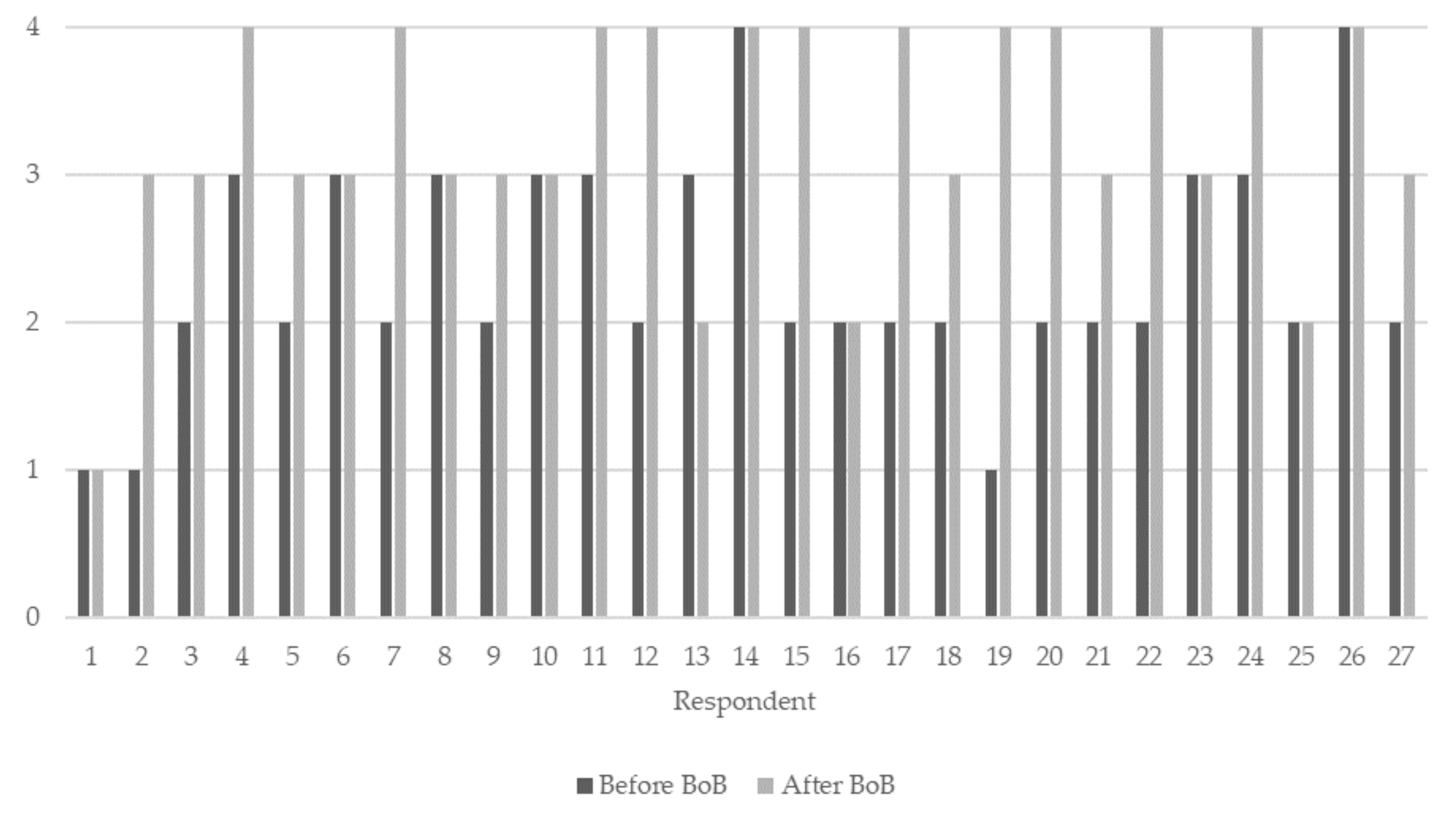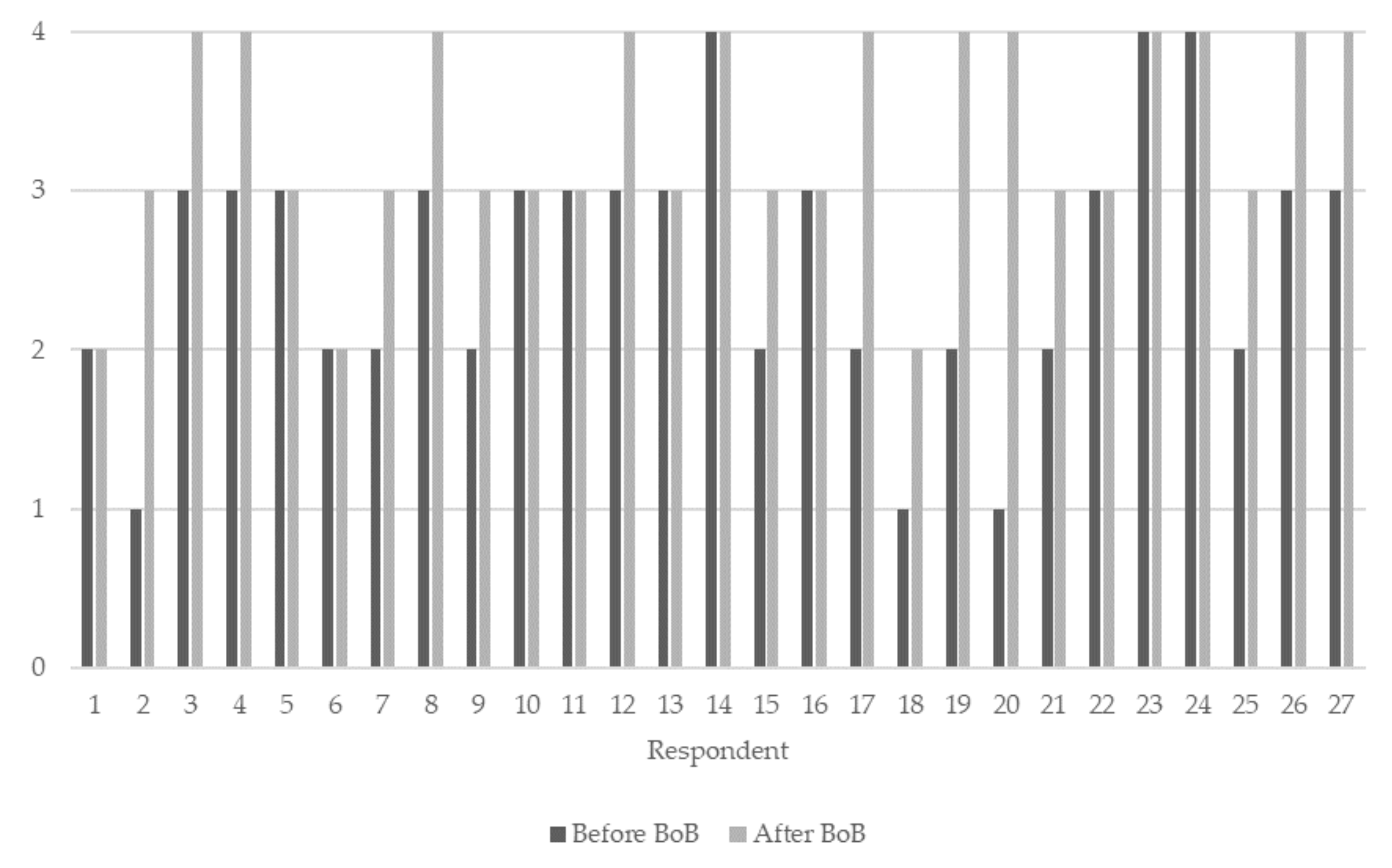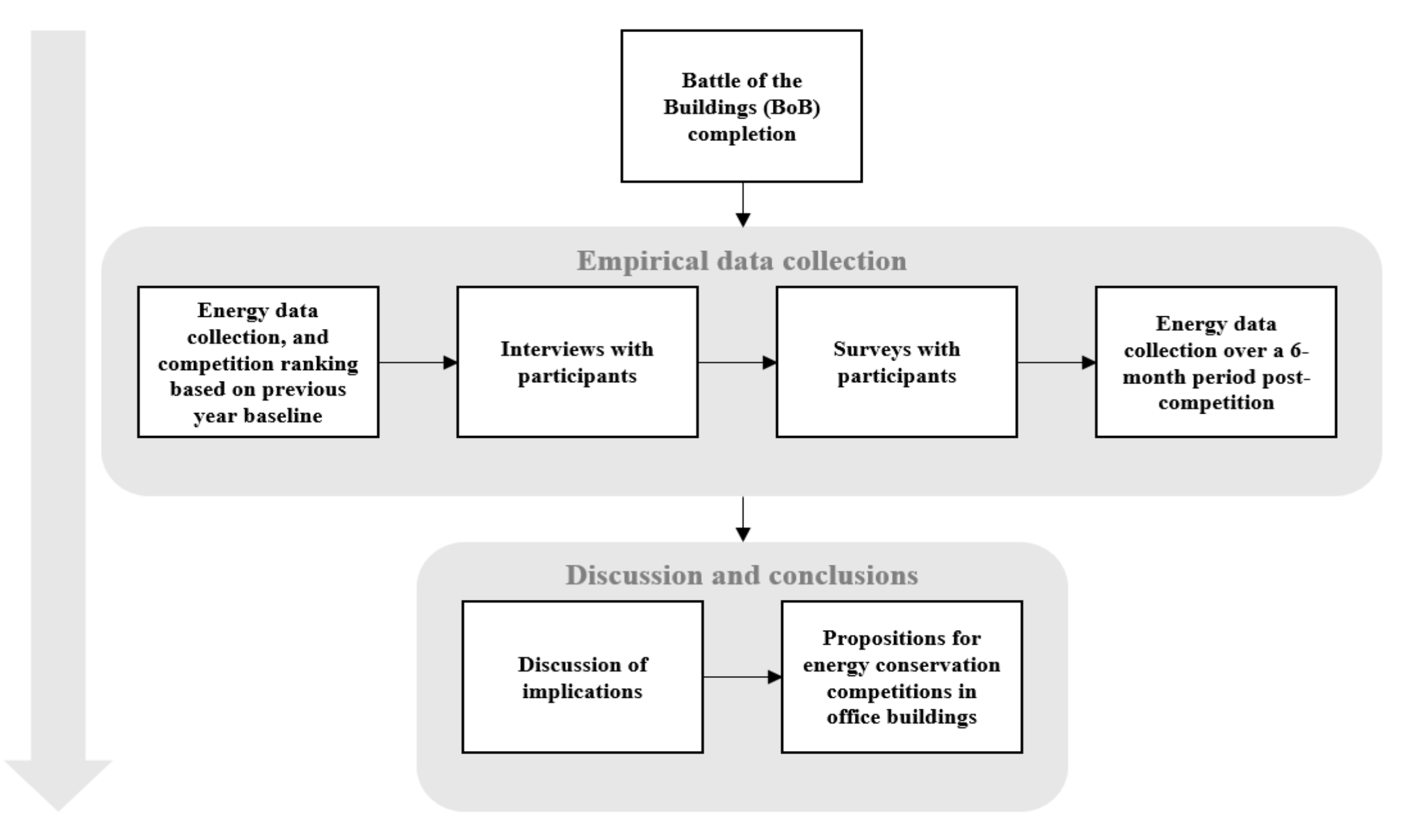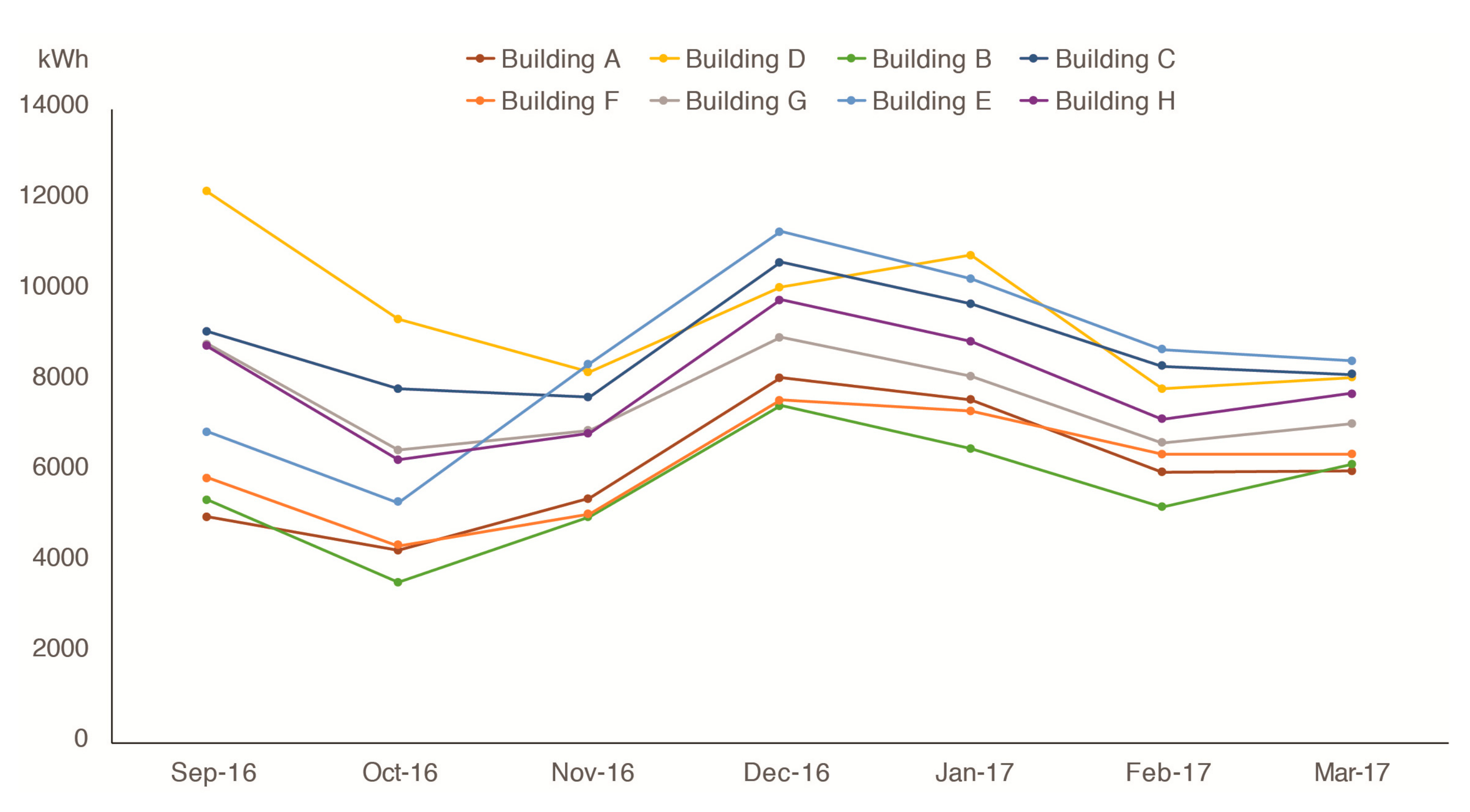Occupant Behavior for Energy Conservation in Commercial Buildings: Lessons Learned from Competition at the Oak Ridge National Laboratory
Abstract
1. Introduction
2. Literature Review
2.1. Occupant Behavior in Residential Buildings
2.2. Occupant Behavior in Commercial Buildings
2.3. Behavioral Change and Social Dynamics
3. Materials and Methods
3.1. Case Description and Energy Data
3.2. Interviews
- -
- What were key drivers of energy conservation during the competition in your building?
- -
- What were key challenges of energy conservation during the competition in your building?
- -
- Would you join an energy conservation competition again? Please explain.
- -
- Do you have any further comments?
3.3. Survey
4. Results
4.1. Interview Findings
- Comfort: Negative effects on thermal comfort (high temperatures and humidity levels) due to decreased air-conditioning (AC). This was discussed as an important element to maintain work productivity.
- Contingencies: Incidents and factors out of occupant control, such as power outages and office appliances, were expressed as vital considerations for improved competition fairness.
- Lack of control: Low level of control, such as of thermostat set-points, schedules and lighting sensors, in automated systems. Interviewees also reported system issues, such as deficient light sensor sensitivity and overly high/low AC temperatures. A mix of automatic and manual control was mentioned by one interviewee as a potential way to maintain comfort levels while also leveraging automation.
- Lack of information: A need for improved information and communication was reported, with clear expectations and targeted information during the competition. Interviewees noted that introductory meetings could aid in this.
- Lack of coordination: Interviewees reported difficulties in contacting facility managers, who could help occupants in energy reduction efforts, e.g., through set-point modifications and updating outdated equipment which are more energy-intensive.
- Lack of involvement: A need for further involvement at the onset of competition-planning was reported. As one interviewee explained: “We want to show that we are doing our part…but we need planning time.”
- Engagement: Reported as vital for energy savings by providing conducive social settings. As expressed by an occupant in Building C: “The strong group dynamics was a main driver. The competition was something we cared about, that we could engage in together.”
- Collective thinking: It was expressed that, through collective ideation and cooperation, higher energy savings was achievable. Collective approaches were reported to enable shared routines for energy use reduction.
- Communication: Communication, internally among co-workers and externally, with the BoB organizers. This was discussed as a facilitator for energy-saving tips shared within co-worker teams, involvement in competition planning, and for regular feedback from competition organizers. Building A interviewees further explained that the self-organized kickoff meeting was influential for knowledge-sharing among co-workers, higher occupant engagement, and participation. As put by one occupant: “Brainstorming made us all get together, share ideas, and look at how to conserve energy. The brainstorming helped us attain full engagement.”
- Competitiveness: Discussed by interviewees as a facilitator of mindfulness of energy use and follow-through on conservation measures.
- Performance visualization: Interviewees explained that the ability to see real-time performance of all buildings contributed to competitiveness, gratification, and motivation.
- New habit development: Interviewees in the top three buildings explained that with increased awareness and mindfulness spurred by the competition, conservation measures were adopted from its onset. As expressed by an interviewee: “The competition helped people be more aware, change mindsets and conserve energy. At the end of the competition, things became more of a habit which will be sustained.”
- Project champion: A leader or advocate within the building to encourage energy saving measures, and keep building occupants informed on competition progress.
4.2. Survey Findings
4.3. Post-Competition Findings
5. Discussion
5.1. Key Success Factors
5.2. Key Challenges
5.3. Multi-Dimensionality of Behavioral Change
- Bottom-up involvement: For example, via (a) an introductory meeting and co-planning with all occupants and relevant facility managers, (b) kickoff/brainstorming meetings in each building, including facility managers, to discuss competition strategies and internal planning. This may contribute to several success factors, including involvement, coordination, leadership, team effort, strategy and routine creation, engagement, and communication among occupants.
- Stakeholder relationship management: For example, pertaining to (a) improved relations among occupants and facility managers able to carry out adjustments, upgrades, or repairs of building equipment. It is suggested that the challenge of lacking (appliance) control can be tackled.
- Targeted information: For example, (a) regular performance reports collectively for each building and for each individual coupled with targeted, actionable feedback on how to further improve energy conservation efforts. This may contribute further to success factors including energy saving tips, awareness, engagement, and the competition as a reminder to conserve energy.
- Real-time visualization: For example, with (a) clearly shown progress demonstrating abilities to impact energy consumption, (b) peer comparison. This may contribute to success factors of the competition as a reminder to conserve energy, increased awareness, progress visualization, and competitiveness.
- Mobile social platform: For example, (a) as a facilitating technology to support social interaction, information-sharing (feedback, tips), progress visualization, communication, and engagement in an integrated manner.
6. Conclusions
Author Contributions
Funding
Conflicts of Interest
Appendix A


References
- Bolton, R.; Foxon, T.J. A socio-technical perspective on low carbon investment challenges—Insights for UK energy policy. Environ. Innov. So. Transit. 2015, 14, 165–181. [Google Scholar] [CrossRef]
- Loorbach, D. Transition Management—New mode of governance for sustainable development. North 2007, 193, 301–314. [Google Scholar]
- Zhao, D.; McCoy, A.P.; Du, J.; Agee, P.; Lu, Y. Interaction effects of building technology and residential behavior on energy consumption in residential buildings. Energy Build. 2017, 134, 223–233. [Google Scholar] [CrossRef]
- Konis, K.; Orosz, M.; Sintov, N. A window into occupant-driven energy outcomes: Leveraging sub-metering infrastructure to examine psychosocial factors driving long-term outcomes of short-term competition-based energy interventions. Energy Build. 2016, 116, 206–217. [Google Scholar] [CrossRef]
- Rafsanjani, H.N.; Ahn, C.R.; Chen, J. Linking building energy consumption with occupants’ energy-consuming behaviors in commercial buildings: Non-intrusive occupant load monitoring (NIOLM). Energy Build. 2018, 172, 317–327. [Google Scholar] [CrossRef]
- Inyim, P.; Batouli, M.; Reyes, M.P.; Carmenate, T.; Bobadilla, L.; Mostafavi, A. A Smartphone Application for Personalized and Multi-Method Intervention toward Energy-Saving in Buildings. Sustainability 2018, 10, 1744. [Google Scholar] [CrossRef]
- Keskin, C.; Mengüc, M.P. On Occupant Behavior and Innovation Studies Towards High Performance Buildings: A Transdisciplinary Approach. Sustainability 2018, 10, 3567. [Google Scholar] [CrossRef]
- Zhang, Y.; Bai, X.; Mills, F.P.; Pezzey, J.C.V. Rethinking the role of occupant behavior in building energy performance: A review. Energy Build. 2018, 172, 279–294. [Google Scholar] [CrossRef]
- Heesen, F.; Madlener, R. Consumer behavior in energy-efficient homes: The limited merits of energy performance ratings as benchmarks. Energy Build. 2018, 172, 405–413. [Google Scholar] [CrossRef]
- Kosonen, H.K.; Kim, A.A. Advancement of behavioral energy interventions in commercial buildings. Facilities 2017, 35, 367–382. [Google Scholar] [CrossRef]
- Hong, T.; Taylor-Lange, S.C.; D’Oca, S.; Yan, D.; Corgnati, S.P. Advances in research and applications of energy-related occupant behavior in buildings. Energy Build. 2016, 116, 694–702. [Google Scholar] [CrossRef]
- Nisiforou, O.; Poullis, S.; Charalambides, A. Behavior, attitudes and opinion of large enterprise employees with regard to their energy use habits and adoption of energy saving measures. Energy Build. 2012, 55, 299–311. [Google Scholar] [CrossRef]
- Pivac, N.; Nizetic, S.; Zanki, V. Occupant behavior and thermal comfort field analysis in typical educational research institution: A case study. Therm. Sci. 2018, 22, 13. [Google Scholar] [CrossRef]
- Delmas, M.A.; Fischlein, M.; Asensio, O.I. Information strategies and energy conservation behavior: A meta-analysis of experimental studies from 1975 to 2012. Energy Policy 2013, 61, 729–739. [Google Scholar] [CrossRef]
- Dietz, T.; Gardner, G.T.; Gilligan, J.; Stern, P.C.; Vandenbergh, M.P. Household actions can provide a behavioral wedge to rapidly reduce US carbon emissions. Proc. Natl. Acad. Sci. USA 2009, 106, 18452–18456. [Google Scholar] [CrossRef] [PubMed]
- Asensio, O.I.; Delmas, M.A. Nonprice incentives and energy conservation. Proc. Natl. Acad. Sci. USA 2015, 112, E510–E515. [Google Scholar] [CrossRef] [PubMed]
- Peterson, J.E.; Shunturov, V.; Janda, K.; Platt, G.; Weinberger, K. Dormitory residents reduce electricity consumption when exposed to real-time visual feedback and incentives. Int. J. Sustain. High. Educ. 2007, 8, 16–33. [Google Scholar] [CrossRef]
- Sintov, N.; Dux, E.; Tran, A.; Orosz, M. What goes on behind closed doors? How college dormitory residents change to save energy during a competition-based energy reduction intervention. Int. J. Sustain. High. Educ. 2016, 17, 451–470. [Google Scholar] [CrossRef]
- Becherini, F.; Lucchi, E.; Gandini, A.; Barrasa, M.C.; Troi, A.; Roberti, R.; Sachini, M.; Di Truccio, M.C.; Arrieta, L.G.; Pockelé, L.; et al. Characterization and thermal performance evaluation of infrared reflective coatings compatible with historic buildings. Build. Environ. 2018, 134, 35–46. [Google Scholar] [CrossRef]
- Roberti, F.; Oberegger, U.F.; Lucchi, E.; Gasparella, A. Energy Retrofit and Conservation of Built Heritage Using Multi-Objective Optimization: Demonstration on a Medieval Building. Available online: http://www.eurac.edu/en/research/technologies/renewableenergy/publications/Documents/EURAC-RenEne_FRoberti-UFilippiOberegger-ELucchi-AGasparella_IBPSA-Italy2015.pdf (accessed on 27 March 2019).
- Staddon, S.C.; Cycil, C.; Goulden, M.; Leygue, C.; Spence, A. Intervening to change behaviour and save energy in the workplace: A systemic review of available evidence. Energy Res. Soc. Sci. 2016, 17, 30–51. [Google Scholar] [CrossRef]
- Staats, H.; Van Leeuwen, E.; Wit, A. A Longitudinal Study of Informational Interventions to Save Energy in an Office Building. J. Appl. Behav. Anal. 2000, 33, 101–104. [Google Scholar] [CrossRef]
- United States Environmental Protection Agency (EPA). L’Oréal USA, I’ve Got the Power—Energy Conservation Challenge. Energy Star Buildings Partner Meeting (11 October 2012). Available online: https://www.energystar.gov/sites/default/files/buildings/tools/L%27Oreal_I%27ve_Got_The_Power.pdf (accessed on 27 March 2019).
- Jain, R.K.; Gulbinas, R.; Taylor, J.E.; Culligan, P.J. Can social influence drive energy savings? Detecting the impact of social influence on the energy consumption behavior of networked users exposed to normative feedback. Energy Build. 2013, 66, 119–127. [Google Scholar] [CrossRef]
- Nor Kalsum, I.M. Sustainable campus and academic staff awareness and behaviour in Malaysia’s institutions of higher learning: A case study of UPSI. Malays. J. Soc. Space 2016, 12, 89–99. [Google Scholar]
- Too, L.; Bajracharya, B.; Khanjanasthiti, I. Developing a Sustainable Campus through Community Engagement: An Empirical Study. Archit. Res. 2013, 3, 42–50. [Google Scholar]
- Wu, A.; Singh, J.; Tikasz, P. Independent Study on Changing Student Behavior to Increase Energy Sustainability and Efficiency at the Macdonald Campus of McGill University. Cons. J. Sustain. Dev. 2013, 10, 154–179. [Google Scholar]
- McKenzie-Mohr, D. Promoting Sustainable Behavior: An Introduction to Community-Based Social Marketing. J. Soc. Issues 2000, 56, 543–554. [Google Scholar] [CrossRef]
- Elsharkawy, H.; Rutherford, P. Energy-efficient retrofit of social housing in the UK: Lessons learned from a Community Energy Savings Programme (CESP) in Nottingham. Energy Build. 2018, 172, 295–306. [Google Scholar] [CrossRef]
- Ajzen, I. Perceived Behavioral Control, Self-Efficacy, Locus of Control, and the Theory of Planned Behavior. J. Appl. Soc. Psychol. 2002, 32, 665–683. [Google Scholar] [CrossRef]
- Triandis, H.C. Interpersonal Behavior; Brooks/Cole Publishing Company: Monterey, CA, USA, 1977. [Google Scholar]
- Bamberg, S.; Ajzen, I.; Schmidt, P. Choice of travel mode in the theory of planned behavior: The roles of past behavior, habit, and reasoned action. Basic Appl. Soc. Psychol. 2003, 25, 175–187. [Google Scholar] [CrossRef]
- Knussen, C.; Yule, F. ‘I’m Not in the Habit of Recycling’ The Role of Habitual Behavior in the Disposal of Household Waste. Environ. Behav. 2008, 40, 683–702. [Google Scholar] [CrossRef]
- Frank, G. Becoming sustainable: Human determinants of change. Sci. Total Environ. 2014, 481, 674–680. [Google Scholar] [CrossRef]
- Ruepert, A.; Keizer, K.; Steg, L.; Maricchiolo, F.; Carrus, G.; Dumitru, A.; Garcia Mira, R.; Stancu, A.; Moza, D. Environmental considerations in the organizational context: A pathway to pro-environmental behaviour at work. Energy Res. Soc. Sci. 2016, 17, 59–70. [Google Scholar] [CrossRef]
- Yin, R.K. Case Study Research: Design and Methods (Applied Social Research Methods), 4th ed.; Bickman, L., Rog, D.J., Eds.; SAGE Publications Inc.: Thousand Oaks, CA, USA, 2009; Volume 5. [Google Scholar]
- Zou, P.X.W.; Xu, C.; Sanjayan, J.; Wang, J. A mixed methods design for building occupants’ energy behavior research. Energy Build. 2018, 166, 239–249. [Google Scholar] [CrossRef]
- Eisenhardt, K.M. Building Theories from Case Study Research. Acad. Manag. Rev. 1989, 14, 532–550. [Google Scholar] [CrossRef]
- Clason, D.L.; Dormody, T.J. Analyzing Data Measured by Individual Likert-Type Items. J. Agric. Educ. 1994, 35, 31–35. [Google Scholar] [CrossRef]
- Brown, J.D. What issues affect Likert-scale questionnaire formats? Shiken JALT Test. Eval. SIG Newsl. 2000, 4, 27–30. [Google Scholar]



| Building | Business Activity | Area Gross (SQF) | Occupancy | Interviewees |
|---|---|---|---|---|
| A | Internal Audit & Legal Directorates | 6988 | 15 | 2 |
| B | Building Technologies Research & Integration Center | 6989 | 16 | 3 |
| C | Benefits and Retirement Services | 6995 | 15 | 4 |
| D | Safeguard and Security Technology Center | 6995 | 14 | - |
| E | Computational Biology and Bioinformatics | 6998 | 29 | 1 |
| F | General Office Building | 6998 | 18 | - |
| G | Life Sciences Data Analysis | 6996 | 44 | 1 |
| H | Training Center | 6995 | 15 | - |
| Building | Rank | Change from Baseline |
|---|---|---|
| A | 1 | −23.16% |
| B | 2 | −14.18% |
| C | 3 | −8.08% |
| D | 4 | −1.73% |
| E | 5 | +10.42% |
| F | 6 | +12% |
| G | 7 | +12.84% |
| H | 8 | +15.29 |
| (1) Comfort | (2) Lack of Control | (3) Contingencies | (4) Lack of Information | (5) Lack of Involvement | (6) Lack of Coordination | |
|---|---|---|---|---|---|---|
| A | ✓ | ✓ | ||||
| B | ✓ | ✓ | ✓ | ✓ | ||
| C | ✓ | ✓ | ✓ | ✓ | ✓ | |
| E | ✓ | ✓ | ✓ | ✓ | ✓ | ✓ |
| G | ✓ | ✓ | ✓ | ✓ |
| (1) Full Engagement | (2) Collective Thinking | (3) Communication | (4) Competitiveness | (5) Progress Visualization | (6) New Habit Development | (7) Project Champion | |
|---|---|---|---|---|---|---|---|
| A | ✓ | ✓ | ✓ | ✓ | ✓ | ✓ | |
| B | ✓ | ✓ | ✓ | ✓ | ✓ | ✓ | ✓ |
| C | ✓ | ✓ | ✓ | ✓ | ✓ | ✓ | ✓ |
| E | ✓ | ✓ | |||||
| G | ✓ | ✓ |
| Unimportant | Somewhat Important | Neutral (N/A) | Important | Very Important | Chi-Square Test (p-Value) | |
|---|---|---|---|---|---|---|
| Lack of time | 13 | 4 | 6 | 4 | 0 | 0.002 |
| Memory | 3 | 9 | 4 | 7 | 4 | 0.323 |
| Lack of leadership | 10 | 6 | 7 | 3 | 1 | 0.058 |
| Co-workers not interested | 3 | 10 | 6 | 3 | 5 | 0.188 |
| Lack of knowledge on how to reduce energy use | 7 | 6 | 8 | 5 | 1 | 0.248 |
| Energy intensive devices needed for work | 2 | 7 | 6 | 8 | 4 | 0.367 |
| Inconvenience | 4 | 9 | 6 | 6 | 2 | 0.284 |
| Sacrificed comfort | 3 | 8 | 4 | 6 | 6 | 0.589 |
| Unimportant | Somewhat Important | Neutral (N/A) | Important | Very Important | Chi-Square Test (p-Value) | |
|---|---|---|---|---|---|---|
| Leadership | 4 | 2 | 3 | 7 | 11 | 0.043 |
| Team effort | 0 | 1 | 2 | 5 | 19 | 3.3 × 10−9 |
| Strategy and routines | 1 | 3 | 3 | 8 | 12 | 0.005 |
| Support and communication among co-workers | 0 | 0 | 4 | 10 | 13 | 3.5 × 10−5 |
| Energy saving tips | 1 | 5 | 2 | 9 | 10 | 0.017 |
| Prize motivation | 7 | 5 | 3 | 6 | 6 | 0.790 |
| Increased awareness | 1 | 1 | 1 | 11 | 13 | 1.8 × 10−5 |
| The competition as a reminder to conserve energy | 1 | 1 | 1 | 14 | 10 | 1.0 × 10−5 |
| Internal incentives/competitions | 2 | 4 | 14 | 3 | 4 | 0.001 |
| Motivated to lead sustainable lifestyle | 2 | 7 | 2 | 9 | 7 | 0.106 |
© 2019 by the authors. Licensee MDPI, Basel, Switzerland. This article is an open access article distributed under the terms and conditions of the Creative Commons Attribution (CC BY) license (http://creativecommons.org/licenses/by/4.0/).
Share and Cite
Ahl, A.; Accawi, G.; Hudey, B.; Lapsa, M.; Nichols, T. Occupant Behavior for Energy Conservation in Commercial Buildings: Lessons Learned from Competition at the Oak Ridge National Laboratory. Sustainability 2019, 11, 3297. https://doi.org/10.3390/su11123297
Ahl A, Accawi G, Hudey B, Lapsa M, Nichols T. Occupant Behavior for Energy Conservation in Commercial Buildings: Lessons Learned from Competition at the Oak Ridge National Laboratory. Sustainability. 2019; 11(12):3297. https://doi.org/10.3390/su11123297
Chicago/Turabian StyleAhl, Amanda, Gina Accawi, Bryce Hudey, Melissa Lapsa, and Teresa Nichols. 2019. "Occupant Behavior for Energy Conservation in Commercial Buildings: Lessons Learned from Competition at the Oak Ridge National Laboratory" Sustainability 11, no. 12: 3297. https://doi.org/10.3390/su11123297
APA StyleAhl, A., Accawi, G., Hudey, B., Lapsa, M., & Nichols, T. (2019). Occupant Behavior for Energy Conservation in Commercial Buildings: Lessons Learned from Competition at the Oak Ridge National Laboratory. Sustainability, 11(12), 3297. https://doi.org/10.3390/su11123297





